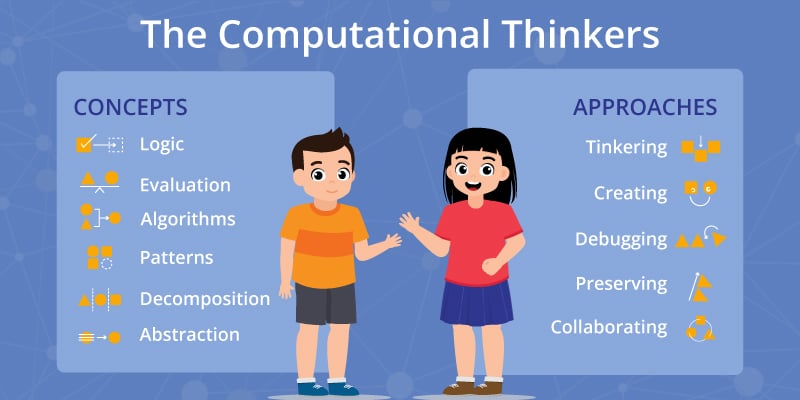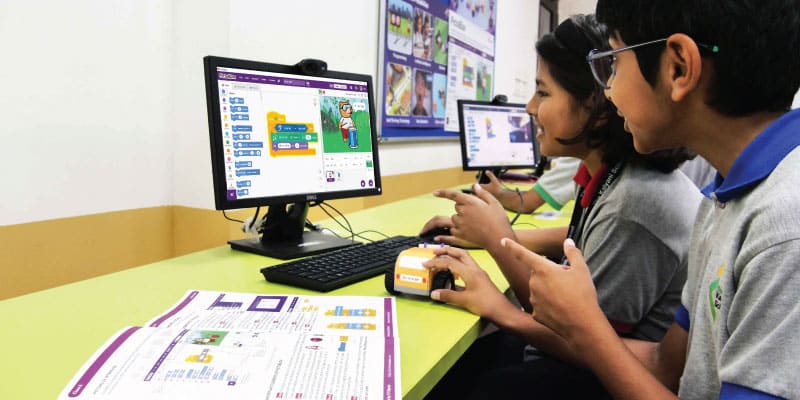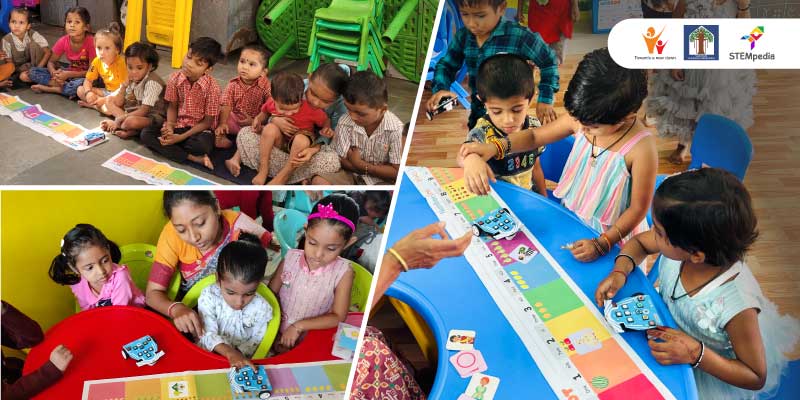In the Ministry of Education, Government of India (MoE)’s latest announcement on 30th October 2025, the country is set to launch a groundbreaking Artificial Intelligence (AI) & Computational Thinking (CT) curriculum from Class 3 onwards, starting with the academic session 2026-27, for all schools.
In an effort to integrate Artificial Intelligence into the classrooms, the CBSE has made an ambitious move that positions India at the forefront of educational innovation. They have drafted a comprehensive Artificial Intelligence and Computational Thinking (AI & CT) curriculum for students from Classes 3 to 12. The transformative initiative, aligned with the National Education Policy (NEP) 2020, represents one of the world’s most extensive integrations of AI education into school learning. Standing at the brink of educational transformation, it’s time to understand what it means for the future of education in India.
The progressive framework aims to liberalise AI education, making it a fundamental universal skill rather than an elite specialisation, and to position it as essential as reading and numeracy. The curriculum will be organically embedded from the foundational stage, beginning in Grade 3, with a focus on “AI for Public Good”.
Key Highlights of the New AI Curriculum

Key components include:
- Introducing AI and CT concepts from Grade 3 onwards, set to roll out in the 2026-27 session, aligned with NEP 2020 and NCF SE 2023.
- Integration of AI and CT curriculum, time allocation and resources under NCF SE.
- Resource development (materials, handbooks, and digital modules) is set to roll out by December 2025.
- Structured, grade-wise teacher training to be offered through NISHTHA and partner institutions within set time frames.
- An expert committee chaired by Karthik Raman (IIT Madras) for curriculum design.
The CBSE’s approach is carefully structured to be age-appropriate and continual, building from basic computational thinking to advanced AI concepts:
CBSE AI and CT Curriculum Framework Across Grade Levels
| Grade Level | Focus Areas | Teaching Approach | Time Allocation |
|---|---|---|---|
| Classes 3-5 | Computational thinking integrated into existing subjects | Embedded within Mathematics, Languages, and "The World Around Us" | Approximately 50 hours |
| Classes 6-8 | Foundational AI concepts + CT integration | Interactive projects, presentations, and reflective journals | About 15 hours currently |
| Classes 9-10 | Advanced CT and intermediate AI as compulsory subjects | Practical programming and problem-solving with AI tools | Part of the formal curriculum |
| Classes 11-12 | AI and Machine Learning as elective subjects | Specialisation in AI concepts, algorithms, and real applications | Comprehensive courses |
CT will be intertwined into existing subjects for the youngest learners in Classes 3 – 5, and not taught as a separate discipline. Imagine if children start learning logical sequencing through language exercises, problem-solving skills through environmental studies and pattern recognition through ecological studies. This integrated approach will ensure that computational thinking becomes a natural approach to learning for kids across all subjects.
The idea is to transition students from being merely technology users to critical thinkers at this stage. They will have a knack for understanding AI’s applications and its limitations as they progress to middle school (Classes 6-8) and begin exploring how AI works through interactive projects.
The curriculum becomes more specialised in secondary classes, with AI becoming a compulsory subject in classes 9-10. It then transforms into an elective specialisation in Classes 11-12, allowing students to delve into machine learning algorithms and their real-world applications.
Implementation Timeline
The rollout of this ambitious curriculum is planned in phases:
Academic Year 2026-27: Implementation for Classes 3-8 begins.
Academic Year 2027-28: Implementation for Classes 9-10 begins.
December 2025: Development of learning materials, handbooks, and digital resources targeted for completion. Along with an expert committee led by Professor Karthik Raman from IIT Madras, the National Council of Educational Research and Training (NCERT) is currently reviewing the draft curriculum and collaborating on its development.
What is Computational Thinking in Education?

Computational or digital thinking is a problem-solving process. It is about learning to solve problems in a way that a computer might, using clear steps and rules. Computational thinking involves four vital conceptual skills, which include:
- Decomposition (breaking down problems)
- Pattern recognition (spotting and using similarities)
- Abstraction (simplifying details)
- Algorithmic design (making steps and rules)
This process will help students understand and solve complex problems both effectively. Think of it like figuring out the best way to organise your daily tasks or finding the quickest route to school. Some computational thinking examples include:
- Breaking a big problem into smaller parts
- Looking for patterns
- Making up rules or steps to solve the problems
Computational thinking activities in class might include fun puzzles or games that teach you how to think step-by-step.
Education in AI and CT: To be Treated as a Universal Skill

By embedding computational thinking across subjects, this curriculum represents a significant shift from traditional rote learning to imbibing critical thinking. This will allow students to approach challenges systematically, recognise patterns in information, and apply technology responsibly to address real-world problems.
“Artificial Intelligence and Computational Thinking (AI & CT) will reinforce the concept of learning, thinking, and teaching, and will gradually expand towards the idea of ‘AI for Public Good.’ This initiative marks a nascent yet significant step towards the ethical use of AI to solve complex challenges, as the technology will be organically embedded from the foundational stage, beginning in Grade 3,” the Ministry of Education said in a statement.
Teacher Empowerment and Support on AI Education

With the help of initiatives like NISHTHA (National Initiative for School Heads’ and Teachers’ Holistic Advancement), the government has framed out comprehensive teacher training programs recognising that teachers are the backbone of this transformation. The training modules will be grade-specific and time-bound, ensuring that educators are well-equipped to deliver the new curriculum effectively.
The Implementation will Follow a Collaborative Teaching Model:

- Grades 3-5: Mathematics and subject teachers will handle computational thinking components.
- Grades 6-8: Teachers from different disciplines will collaborate to integrate CT and AI concepts.
- Grades 9-12: Computer science teachers will lead AI-focused instruction.
Opportunities and Challenges

Bridging the Digital Divide
Addressing the digital divide will also be crucial to this initiative, as it faces significant implementation challenges. Moreover, about 50% of Indian schools lack basic digital infrastructural necessities like electricity, internet, and computers to ensure equitable access to AI education across both urban and rural settings.
The government is exploring innovative solutions, such as “unplugged learning” activities that teach AI concepts without digital devices, making the curriculum accessible even in schools with limited resources.
Balancing Screen Time and Holistic Development
Educators have expressed concerns about balancing technology integration with essential childhood experiences. As Devyani Jaipuria, Chairperson of Dharav High School, notes: “Digital tools have significantly enriched the learning experience… however, an over-reliance on technology, especially in early education, can limit imagination, reduce attention spans, and hinder the development of essential social and emotional skills”.
The curriculum ultimately aims to address these concerns by taking a balanced approach which combines AI education with physical activity, traditional learning methods and creative pursuits.
Implement AI Curriculum in Your School
CBSE’s new AI and CT curriculum takes a significant leap towards aligning India’s education system with the global technological shifts. Introducing AI and computational thinking early can empower students to become creators, not just consumers, in a tech-driven world. As observed, early exposure can foster creativity and critical thinking when guided ethically. This initiative positions India among global AI education pioneers, shaping a generation of responsible innovators. In other words, its success now depends on thoughtful implementation, strong teacher support, and a balanced approach that nurtures both tech skills and human values.









